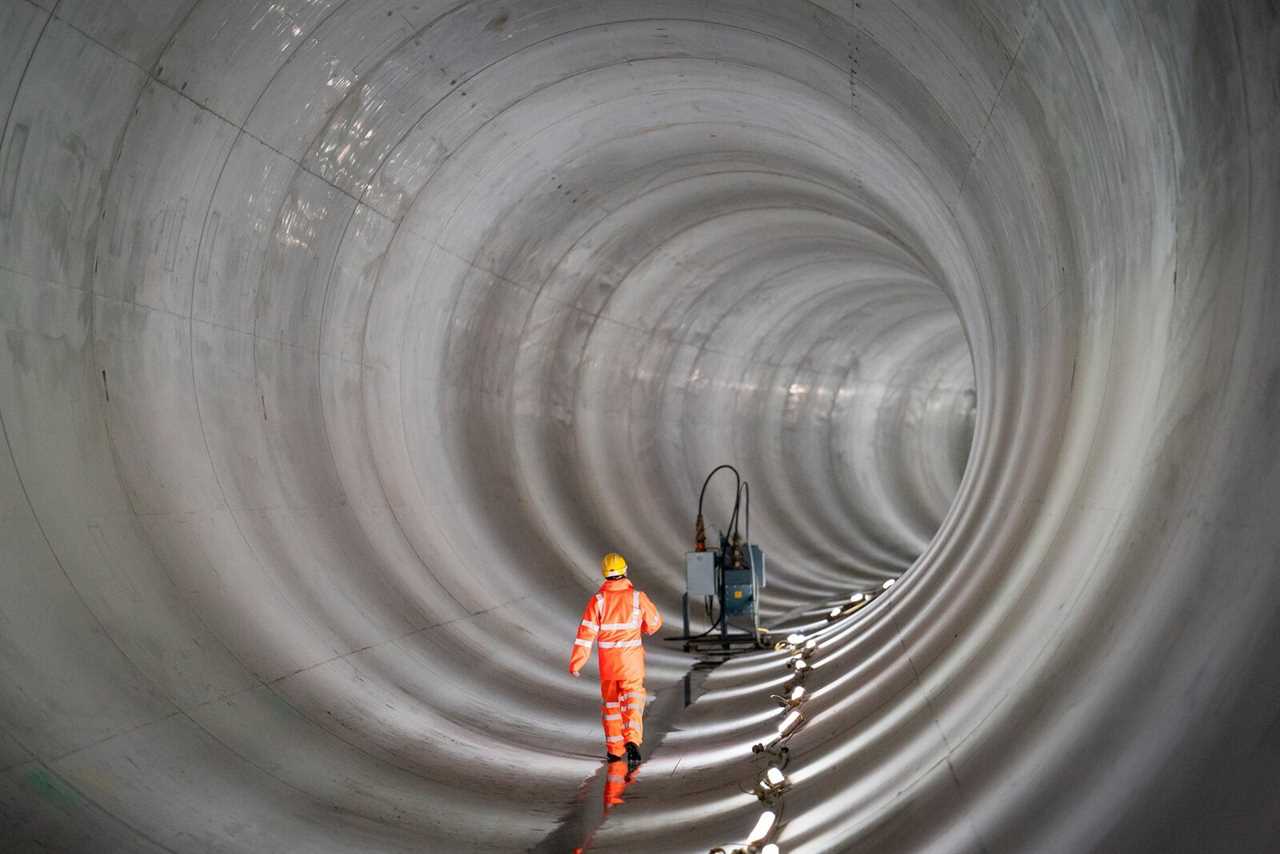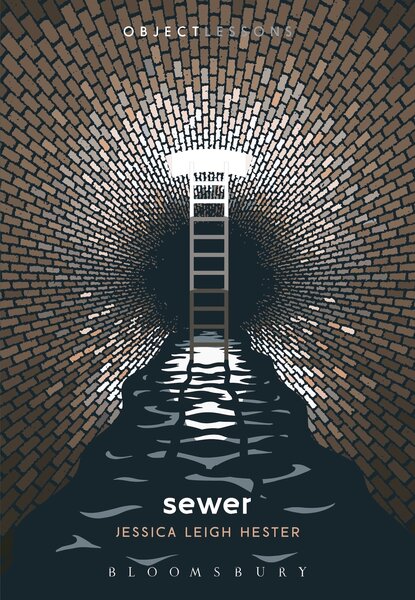The underground systems humans have created to deal with our own waste can be seen as mirrors to the world above. To weather the 21st century, we need to update them accordingly.

"If it’s noisy down there, we’ll give you earplugs," Oliver Smith told me. It was a sunny Wednesday morning in September 2019, and we were walking to a construction site. "I think for the moment, it should be quite quiet," he added. "The guys might be on a break."
Quiet is relative. When I listened to my audio recordings later in my hushed apartment, I heard revving and roaring; it sounded like jackhammers had taken up residence in my ear canals. But Smith might not have noticed the sounds that rattled me; he could be inured to them. His crew works long shifts, and I wondered if the din clung to them the way the smell of the fatberg had woven itself into my garments—if it stayed with them after they’d stowed their tools and returned home.
We were at the Albert Embankment site, where the River Thames ducks under the Vauxhall Bridge in London. We could see the revolving carriages of the London Eye, the wheel that soars over the city. But instead of going up, Smith and I were going down—down flight after flight of stairs to a pit that led into the mouth of a massive sewer pipe.
With his crew, Smith, an engineer on the project, was building one portion of the Thames Tideway Tunnel, a sprawling system that will vastly increase the holding capacity of the city’s beleaguered sewers. To do it without disrupting the underground infrastructure that already supports London life, the crew must tunnel through prehistoric ground.
Close to the surface, London’s soils are rich with clay. Compressed over millennia, the sediment is strong, but yielding. It’s "really good for tunneling," Smith told me. Go deeper, and you’ll eventually hit a stratum known as the Lambeth Group. That’s "more stony, tougher, a bit more like shale," Smith said. Rockier layers are less cooperative when they meet human tools, and that slows construction. Eventually, Smith told me, they’d be even deeper, touching ground that "hasn’t seen surface for millions of years."
The investment that’s needed to fix or fend off sewer-related problems often exceeds the city, state, and federal funds earmarked for those overhauls.
In slews of places, wastewater infrastructure renovation projects are struggling or terribly behind schedule. Gibraltar, the British territory on Spain’s southern coast, is saddled with a treatment-plant boondoggle years overdue. (One problem is the water; little is desalinated, and residents flush their toilets with water laced with corrosive salt.) In places where sewers and wastewater treatment plants do exist, they’re often outdated or under-performing. In March 2021, the American Society of Civil Engineers (ASCE), which issues a regular report card grading the state of the country’s infrastructure, gave a D+ to the U.S.’s wastewater treatment plants and 1,300,000 miles of sewers.
The near-flunking grade is no surprise. Many of the country’s wastewater treatment systems were built in the 1970s—the era of the Clean Water Act, and the last major investment in sewers—and are wearing out as they age. Most treatment plants were designed to have a lifespan of no more than 50 years, according to the ASCE, which means these facilities have entered their twilight. Some sewers are much older, even approaching supercentenarian status: Close to 20 percent of the pipes that wind stormwater beneath Boston were built before the first World War, reported local radio station WBUR. A share of London’s beleaguered pipes has been in the ground since Bazalgette’s compatriots laid them there in the 19th century.
The investment that’s needed to fix or fend off sewer-related problems often exceeds the city, state, and federal funds earmarked for those overhauls. The ASCE reports that, in 2019, investments in water and wastewater infrastructure fell $81 billion short of the money required for existing issues. The Biden administration’s proposed infrastructure plan would offer some assistance for municipal projects that would aim to recover stormwater before it overflows, and also funnel money toward decentralized wastewater treatment systems in individual homes.
Unfortunately, in the United States and elsewhere, aged pipes are increasingly overloaded: In 2021, 15 percent of the country’s wastewater treatment plants were intercepting more water than they were designed to encounter, according to the ASCE report. That’s partly because many sewer systems are catering to populations much larger than the ones they were built to serve—but it’s also because rain is dumping more water into the system.
Scientists expect that as the climate continues to warm, many parts of the planet will be spattered by bursts of fierce rain, even as other swaths weather brutal droughts. (Both are consequences of increased evaporation, according to NASA researchers.) For sewers, climate change will, as WBUR environment reporter Miriam Wasser put it, be akin to "turning up the water pressure." Wetter weather means more water rushing off streets, into catch basins, through pipes, and out into bodies of water—and these deluges are especially damaging when coupled with general sea-level rise.
In tidal areas, many outfall sewers are designed to afford plentiful space for water to slosh out at low tide and then disperse when the water flows back in. That’s one process by which bacteria scatter, lowering E. coli levels after an overflow. A water level that constantly hangs higher makes it hard for stormwater to spit out into whatever body of water it’s designed to enter; it might even cause water to splash backwards in the pipe. "You can’t just think about rain, you can’t just think about wastewater, you can’t just think about sea-level rise," Sanjay Seth, Boston’s climate resilience program manager, recently told WBUR—all of those factors are tangled together in one dripping, fetid knot.
To stunt the impact of rain, many cities are trying to store water or slow its movement with the help of green spaces, patchworking the urban grid with rain gardens and other plantings that soak up water that would otherwise hurry into streets. Other officials are gathering data that can help them anticipate stormwater and wastewater problems, and manage the systems intended to stanch them. These include so-called "smart sewers," outfitted with sensors—often affixed to the underside of the street-facing cover—that track flow, volume, and more. Some places use real-time monitoring to make quick changes (even automatic ones) to the way that sewers or stormwater collection operate.
The city of Hawthorne, California, for instance, installed 50 sensors to track water levels in real-time, helping identify places where daily patterns are fluctuating and where there may be an intruding tree root or a build-up of fats, oils, and grease. Since the sensors were added in 2006, the city has seen a 99 percent reduction in sewer overflows. South Bend, Indiana, has become a charismatic poster child for smart sewers. In 2012, the city moved its stormwater management to the cloud. It also debuted automated gates that help control the release of stormwater into the combined sewers. The interventions paid off: Between 2008 and 2014, the city slashed its overflows by 1 billion gallons a year, giving then-mayor Pete Buttigieg something to brag about.

Courtesy of Bloomsbury
With many sewers pushed beyond their limits, "water companies have no choice" but to occasionally release untreated sewage and stormwater into bodies of water, explained Petra Cox, of England’s Crossness Engines Trust. Such spills are an unpopular solution to a tricky problem. Working with their current infrastructure, water companies are somewhat stuck, Cox said. "They’re getting fined, breaking rules, just because there’s nothing to be done."
Several places are trying to stave off these problems by scaling up. Chicago—which has a long, choppy relationship with wastewater, and even reversed the flow of its riverine artery to haul sewage away from Lake Michigan, the source of drinking water—is building sprawling holding tanks that resemble lagoons. Singapore is digging deep tunnels. Scaling up is precisely what the Tideway’s engineers plan to do. The 15-and-a-half-mile tunnel is designed to intercept some potential overflows and shunt them into holding tanks deep enough underground to dodge subway lines. Instead of disgorging into the Thames, the diverted sewage will travel to a treatment facility.
Backboned by concrete veined with steel fibers, the tunnel is designed to require very little maintenance for several decades, and to safeguard the river for at least a century. The tube yawns nearly 24 feet in diameter; Smith likened it to trading up from a fish tank to a swimming pool, without having to deep-six the existing pipes. Designed with a population of 16 million in mind, it’s built to cater to twice as many people as lived in London in 2019 without ever truly filling to the brim.
Projects on this scale aren’t universally adored. Some critics think the Tideway’s £4 billion price tag is excessive, particularly because some of it falls to customers, whose water bills are rising to cover the ballooning cost. (By summer 2021, customers had seen an increase of £18 a year, and some critics expected it to keep inching up to account for the project’s delays amid the COVID-19 pandemic.) England’s National Audit Office has found that, though the project shaved off several miles of tunneling from the design more than a decade ago, the tunnel could probably still have been shorter and less cavernous, though a narrower tunnel wouldn’t have slashed costs the way that a shorter one did, and may have been too slender to do its job.
Meanwhile, some researchers think that the infrastructure calls for different kinds of tinkering, too. Beyond expanding carrying capacity or storage space, they figure that the function of sewers and wastewater treatment plants should evolve in a more expansive way. That may involve making more from the byproducts of poop and other stuff that winds up in the pipes (digesters, for instance, can transform feces into usable biogas, which can power all sorts of things, from stoves to lights). Others believe the priority should be preserving or adding green space to wrangle water before so much of it ends up underground. And still other researchers argue that improving sewers and wastewater treatment plants entails reimagining the functions they can fulfill in the communities they serve. In addition to getting bigger, that idea goes, sewer facilities ought to broaden their scope.
On the way to the pit at the Albert Embankment construction site, I passed a green-and-white sign. It held a mirror with a caption that read, "Meet the person responsible for your own safety." I photographed myself smiling into the glassy surface, clutching my notebook in one hand and teal hardhat in the other.
The message made me laugh. It was a playful threat and a clever admonishment: The site had safety procedures in place, but I also needed to keep my wits about me. From holding on to the railings to not wandering in front of the machines, I had a role to play in averting disaster.
Later, the sign struck me as a metaphor for the sewer system itself. There are many measures in place to help keep things flowing, from fatberg-busting crews to pipes big enough to compensate for the ripple effects of our actions, past, present, and future. In one sense, bigger pipes exonerate us, or at least insulate us against the brunt of our behaviors. But the individual choices we make—the wipes we flush, the oil we dump—make a difference, too. We should all be part-time sewer safety wardens. Hard hats optional.
The above excerpt is reprinted with permission from Sewer by Jessica Leigh Hester, published by Bloomsbury Academic, an imprint of Bloomsbury Publishing. It has been condensed by Dwell editors.
Top photo by Dominic Lipinski/PA Images via Getty Images.
Related Reading:
Facing Our New Climate Reality
The Ups and Downs of Livability Rankings
Read More
By: Jessica Leigh Hester
Title: Why the Unsexy Sewers Beneath Our Feet Are Key to Safeguarding the Future
Sourced From: www.dwell.com/article/why-the-unsexy-sewers-beneath-our-feet-are-key-to-safeguarding-the-future-c784d24e
Published Date: Thu, 27 Oct 2022 21:21:27 GMT
.png)





